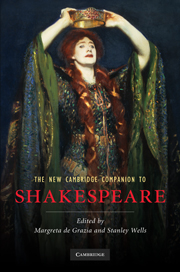Book contents
- Frontmatter
- 1 The traces of Shakespeare’s life
- 2 Shakespeare’s reading
- 3 Shakespeare’s writing: from manuscript to print
- 4 The theatre of Shakespeare’s London
- 5 The transmission of Shakespeare’s texts
- 6 Shakespeare and language
- 7 Shakespeare the poet
- 8 Shakespeare’s comedies
- 9 Shakespeare’s tragedies
- 10 Shakespeare’s English history plays
- 11 Shakespeare’s classical plays
- 12 Shakespeare’s tragicomedies
- 13 Shakespeare, religion and politics
- 14 Shakespeare and race
- 15 Shakespeare, sexuality and gender
- 16 Shakespeare on the stage
- 17 The critical reception of Shakespeare
- 18 Shakespeare and popular culture
- 19 Shakespeare and globalization
- 20 Shakespeare and media history
- 21 Shakespeare: reading on
- Index
9 - Shakespeare’s tragedies
Published online by Cambridge University Press: 28 January 2011
- Frontmatter
- 1 The traces of Shakespeare’s life
- 2 Shakespeare’s reading
- 3 Shakespeare’s writing: from manuscript to print
- 4 The theatre of Shakespeare’s London
- 5 The transmission of Shakespeare’s texts
- 6 Shakespeare and language
- 7 Shakespeare the poet
- 8 Shakespeare’s comedies
- 9 Shakespeare’s tragedies
- 10 Shakespeare’s English history plays
- 11 Shakespeare’s classical plays
- 12 Shakespeare’s tragicomedies
- 13 Shakespeare, religion and politics
- 14 Shakespeare and race
- 15 Shakespeare, sexuality and gender
- 16 Shakespeare on the stage
- 17 The critical reception of Shakespeare
- 18 Shakespeare and popular culture
- 19 Shakespeare and globalization
- 20 Shakespeare and media history
- 21 Shakespeare: reading on
- Index
Summary
'There is no such thing as Shakespearian tragedy,' a distinguished critic has declared, 'only Shakespearian tragedies.' One reason for the remarkably various character of the plays customarily assigned to this genre is that Shakespeare and his contemporaries had no very clear prescription for the kind of work a tragedy ought to be, beyond the simple working assumption that it would be concerned with death and the downfall of the mighty. The term itself was derived from Greek and Roman practice, but like so much else in the European Renaissance, most tragedies of the period were less recoveries of ancient forms than radical reinventions cloaked in classical authority. In this they resembled the playhouses for which they were written. When the entrepreneur James Burbage erected London's first purpose-built playhouse in 1576, he dignified it with a grandly Latinate name whose pretensions were reflected in the 'gorgeous' architectural ornament that reminded contemporaries of 'Roman work'. Looking now at the strange architectural amalgam in Johannes de Witt's sketch of the Swan (see Figure 1), we may be struck less by the classical pretensions of the two great columns that support the 'heavens' over its platform stage than by the vernacular form of an auditorium that strongly resembled the wooden animal-baiting arenas that preceded the playhouses on the Bankside in Tudor London. But, associated as they were in the official mind with such riff-raff as 'Fencers Bearwardes . . . Mynstrels Juglers Pedlers [and] Tynkers', the players sought to advertise the prestigious ancestry of their craft in every way they could.
- Type
- Chapter
- Information
- The New Cambridge Companion to Shakespeare , pp. 121 - 136Publisher: Cambridge University PressPrint publication year: 2010
- 2
- Cited by



